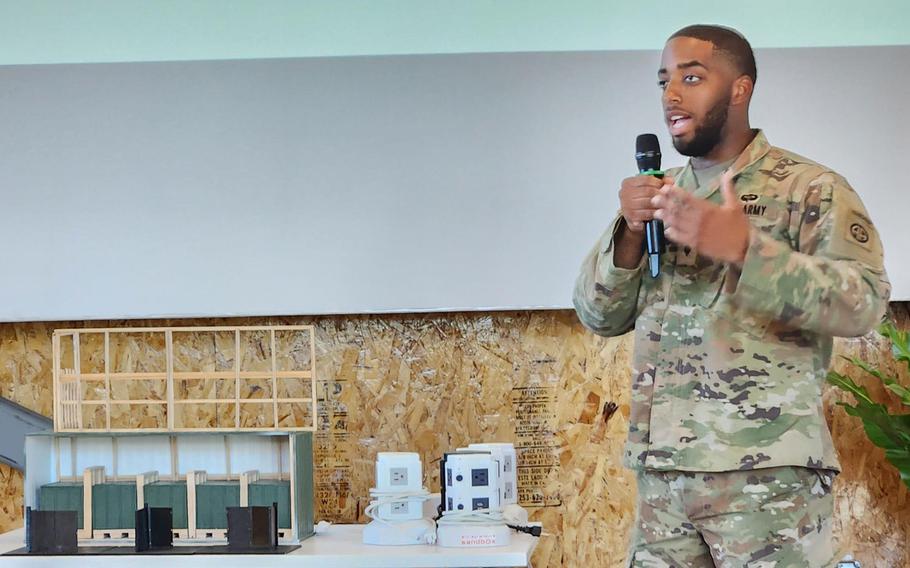
Spc. Akin Atkins, of the 82nd Airborne Division, pitches his team’s idea for more efficiently filling shipping containers during the Dragon’s Lair Innovation Competition in Honolulu on Nov. 2. (Wyatt Olson/Stars and Stripes)
FORT SHAFTER, Hawaii — As a chief hospital corpsman with Afloat Training Group Middle Pacific in Hawaii, Patrick McTavish knows how time-consuming and even dangerous it can be to hoist patients on stretchers up ladder wells on Navy ships.
“We train all the medical departments on the waterfront, and so one of the things that we’re tasked with doing is helping them to transport patients from the point of injury to the medical department for advanced treatment,” he told Stars and Stripes on Thursday.
“And the thing that I saw is that getting a patient from four decks down, from the bottom hold of the ship, whether it’s an engine space, or [other] compartment that’s down low, there’s a pinch point where it takes a long time to stop in the ladder well, to rig the patient with an attending line at the ladder well, and then to hoist them up. And sometimes, if you’re four decks below, you’ve got to do that four times.”
McTavish saw a better way, and on Thursday he was named a runner-up at the “Shark Tank”-style Dragon’s Lair Innovation Competition in Honolulu.
It was the ninth iteration of the contest, which was developed in August 2020 by the XVIII Airborne Corps and now gives members of all ranks and service branches an opportunity to pitch their ideas and concepts to a 10-judge panel of civilian technical experts and senior military leaders.
Among the judges on Thursday were Adm. John Aquilino, head of U.S. Pacific Command; Lt. Gen. James Jarrard, deputy commander of U.S. Army Pacific; and Doug Beck, director of the Defense Innovation Unit.
“From the strategic perspective, the American spirit of innovation is a critical asymmetric advantage,” Aquilino said in a statement Thursday.
“This competition demonstrates our ability to develop alternative, advanced solutions to shared challenges across Combatant Commands and allows us, alongside our allies and partners, to address critical challenges across the global commons,” he said.
‘Make us better’
The Airborne Corps partners with a different command for each iteration of the contest and the location for final judging moves each time.
“It is amazing to meet the talent in our young soldiers,” Jarrard told Stars and Stripes before the eight finalists presented their ideas to the judges.
“One of the problems we have in our military is we’re a large bureaucracy, and so we have bureaucratic processes, which are mind-numbing and time-consuming,” he said.
Jarrard said he was looking for ideas that add value and “make us better.”
“At some level they’re going to make a soldier’s life better, a sailor’s life better, a Marine’s life better and easier, and allow them to be more effective,” he said.
McTavish’s idea — and the prototype he made from it — has the benefit of simplicity. He uses a compact collection of rock-climbing pullies and slings that speed up the lift while easing the overall effort needed for the hoist.
“And so, where it would take maybe five minutes to rig before, we can get it rigged in under a minute now,” he said. “So, if you’re three decks below you save 15 minutes, just in the rigging of the system, not to mention the speed, that you’re actually assisting the patient up the ladder well.”
The contest winner receives an Army Meritorious Service Medal and attendance at an Army school of their choice. The XVIII Airborne Corps works to implement the winning ideas.
Real motivation
Taking first place Thursday was an idea by a pair of soldiers from the 3rd Infantry Division described as an “Electromagnetic Warfare Decoy Emitter.”
The emitter is intended to replicate the kinds of electronic signals made by U.S. forces, thereby deceiving and confusing the enemy. It can also be used to jam enemy frequencies.
Capt. Christopher Flournoy told the judges that because of the low cost of making emitters, they could be liberally deployed to add to the deception’s complexity.
A team from the 11th Cyber Battalion at Fort Gordon, Ga., made a laptop-sized prototype device that monitors enemy frequencies, translates them into English and transcribes them into text.
Chief Warrant Officer 4 Aaron Foster said before the judging that he and teammate Capt. Samuel Miller were motivated by stories from the war in Ukraine in which Russian troops were using off-the-shelf radio transmitters whose signals were easily overheard.
U.S. soldiers could glean a lot from such transmissions if they could have it translated in real time, Foster said. The team’s device feeds transmissions into an artificial intelligence-driven algorithm, and it then goes into a database where it can be accessed in real time.
Translations are not perfect, Miller conceded. But as he wrote on the team’s entry synopsis, as an intelligence officer he “would have gladly taken a 70% accurate translation software system to provide immediate feedback over a 12-hour delay for a linguist to translate communications.”